Abstract
Escherichia coli heat-stable enterotoxin II (STII) is composed of 48 amino acid residues. Among these, one histidine, two arginine, and six lysine residues are basic. Isoelectric focusing showed that the isoelectric point of STII is 9.7, indicating that the side chains of some of these basic amino acid residues project outside the molecule. To understand the role that these basic amino acid residues play in toxicity, STII was chemically modified with ethoxyformic anhydride, maleic anhydride, and phenylglyoxal, which alter the side chains of basic amino acid residues in proteins. Maleic anhydride, which modifies the epsilon amino group, caused a significant loss of enterotoxic activity, but the other two modifiers did not. This indicated that lysine residues play an important role in the expression of the enterotoxic activity of STII and that the contribution of the other basic amino acid residues to the toxicity is relatively low. To confirm this hypothesis, we substituted these nine basic amino acid residues by oligonucleotide-directed site-specific mutagenesis and examined the enterotoxicity of these purified mutant STIIs. The enterotoxic activity was reduced when the lysine residues at positions 18, 22, 23, and 46 were substituted. In particular, the substitution at positions 22 and 23 induced a remarkable reduction. These results demonstrate that the lysine residues at positions 22 and 23 are very important in the expression of the enterotoxic activity of STII.
Full text
PDF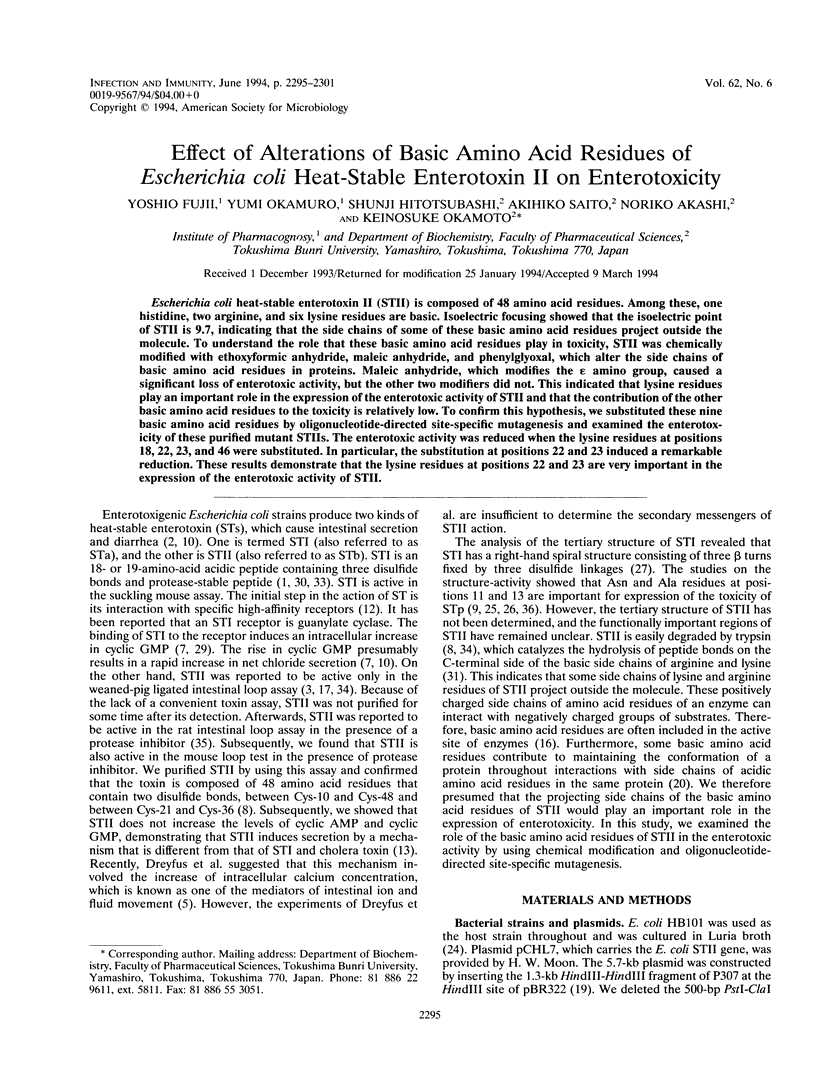
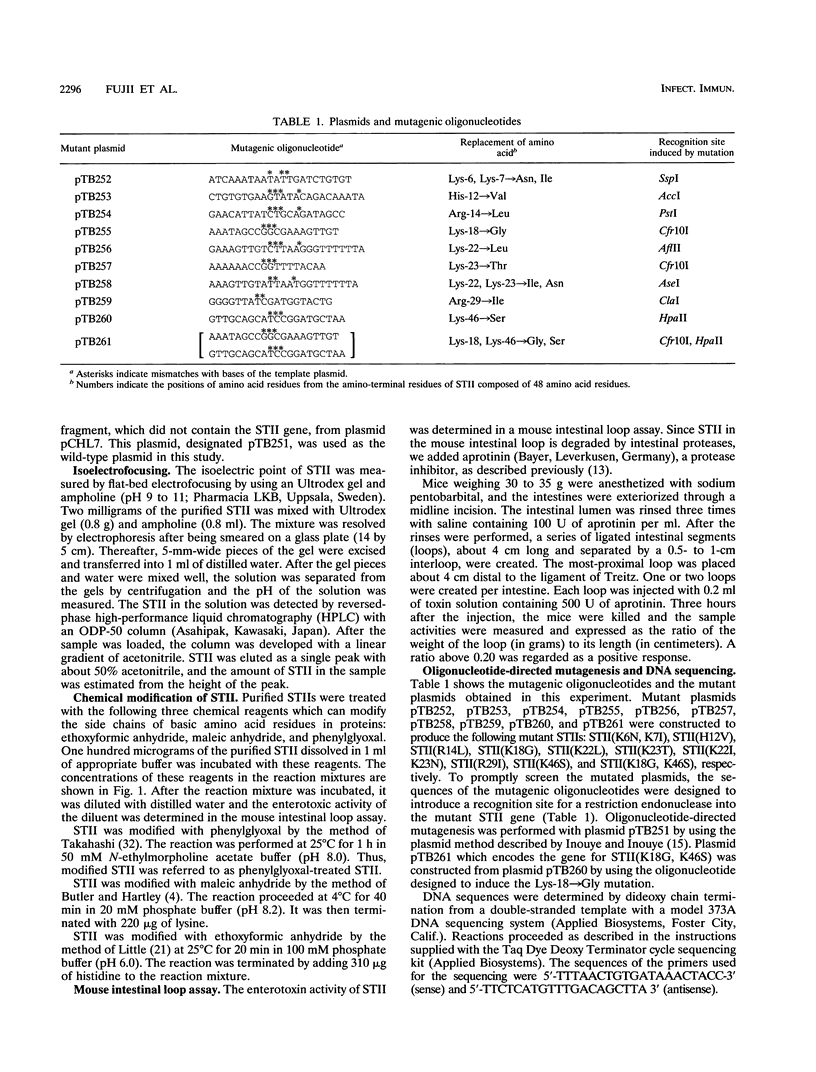
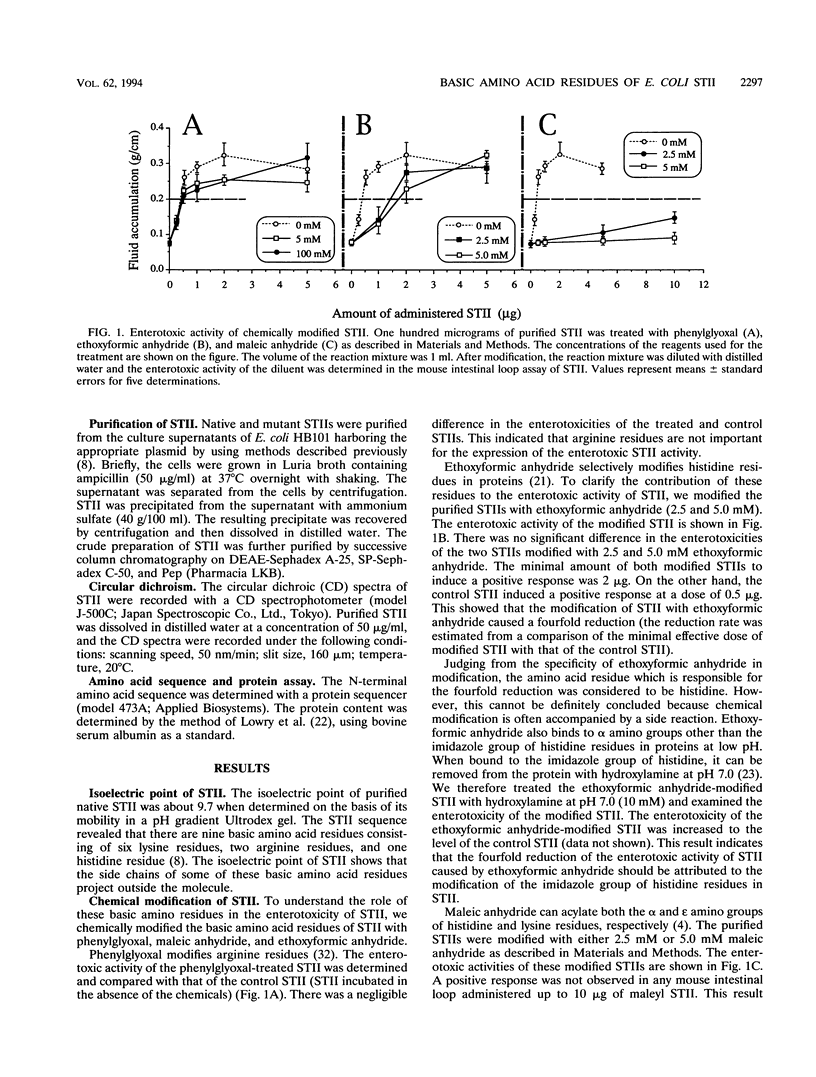
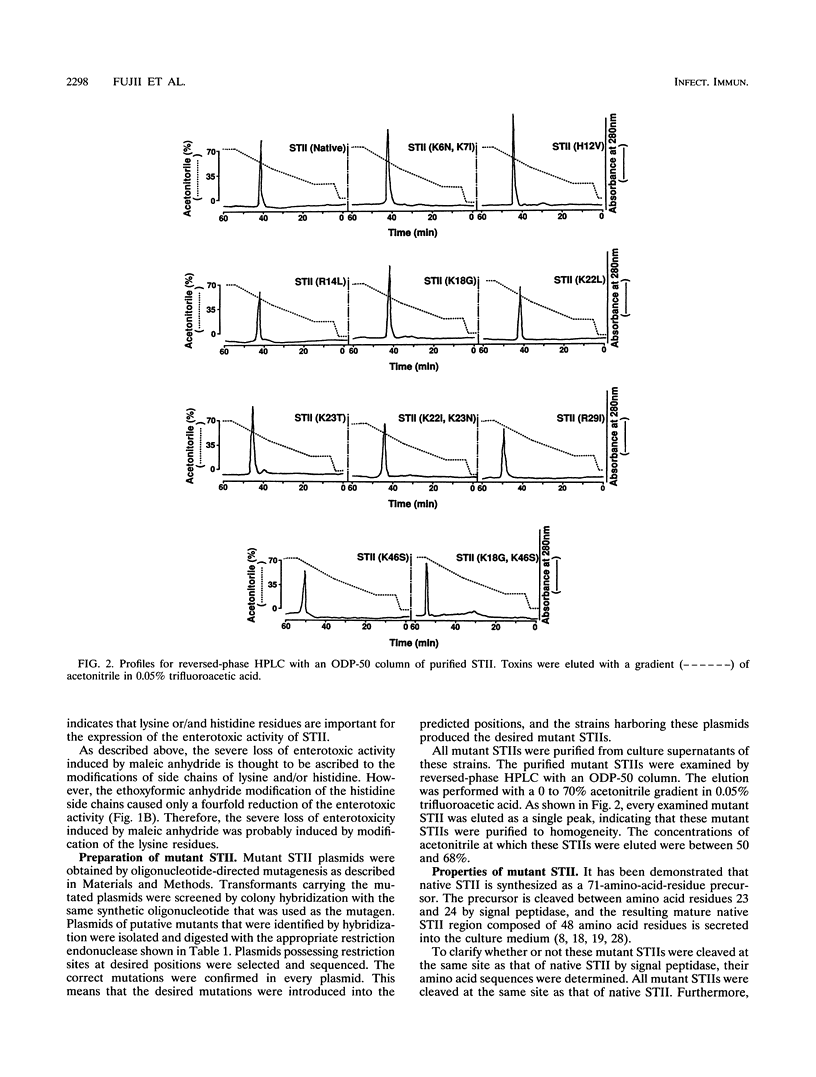
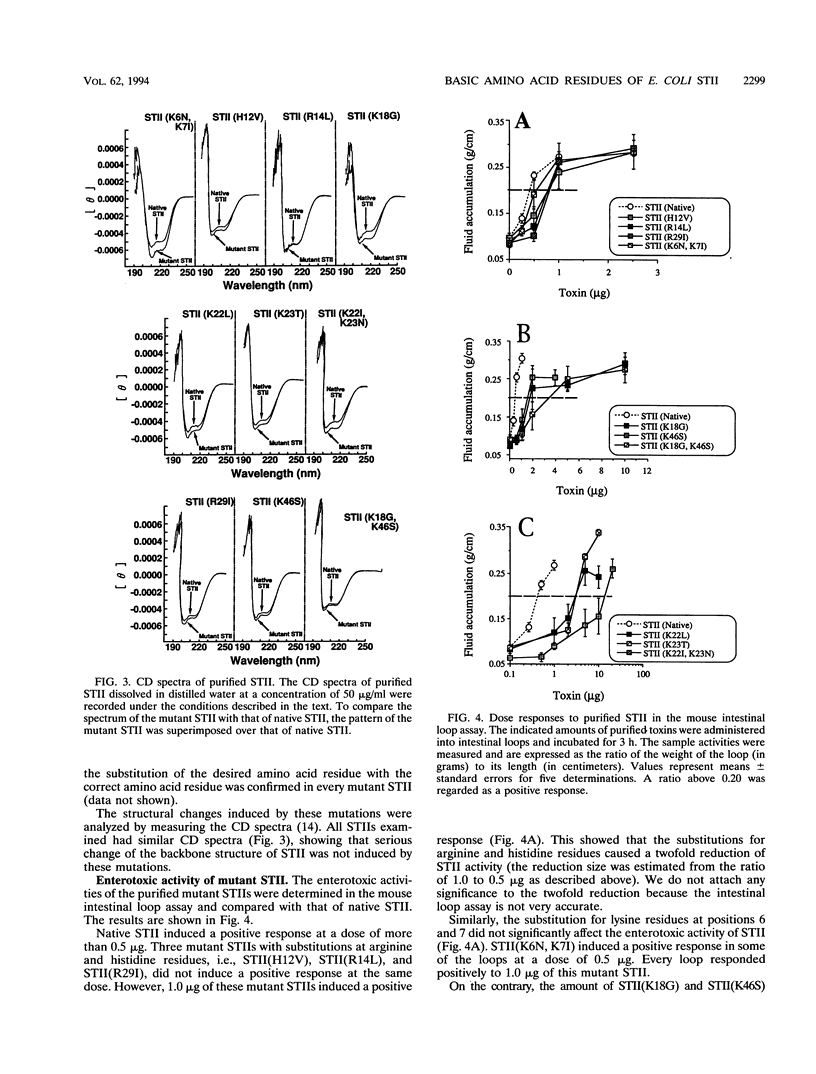
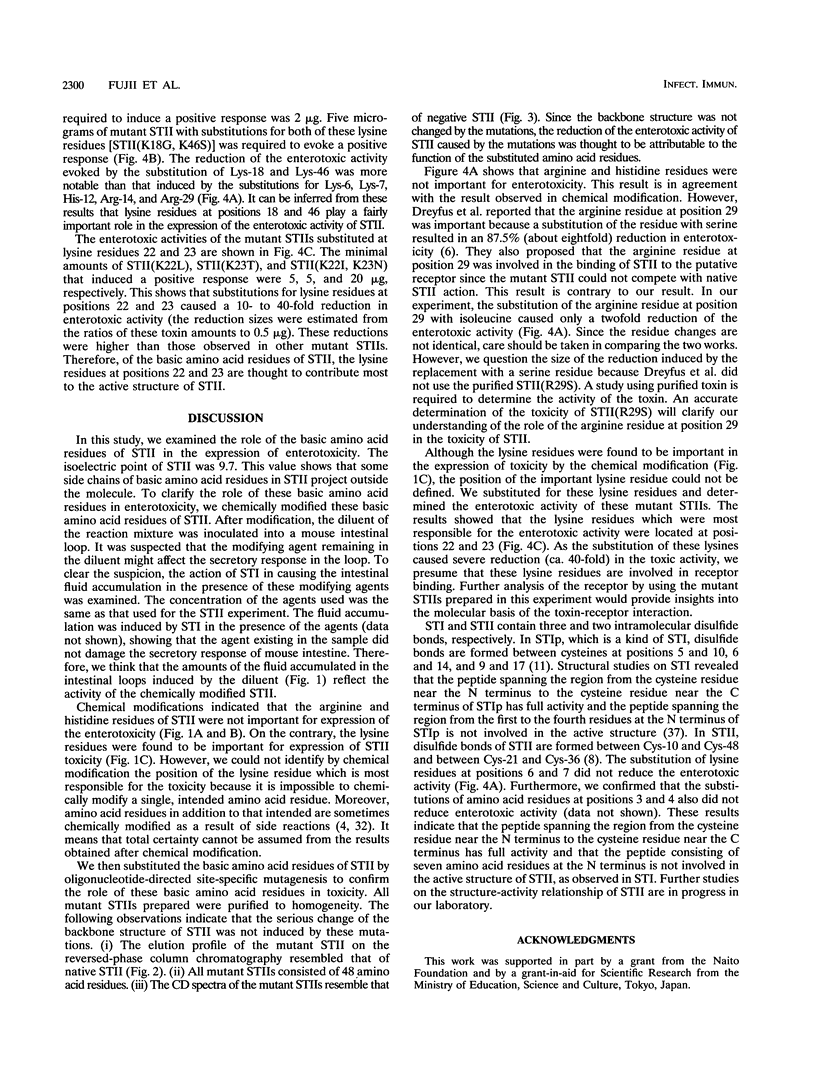
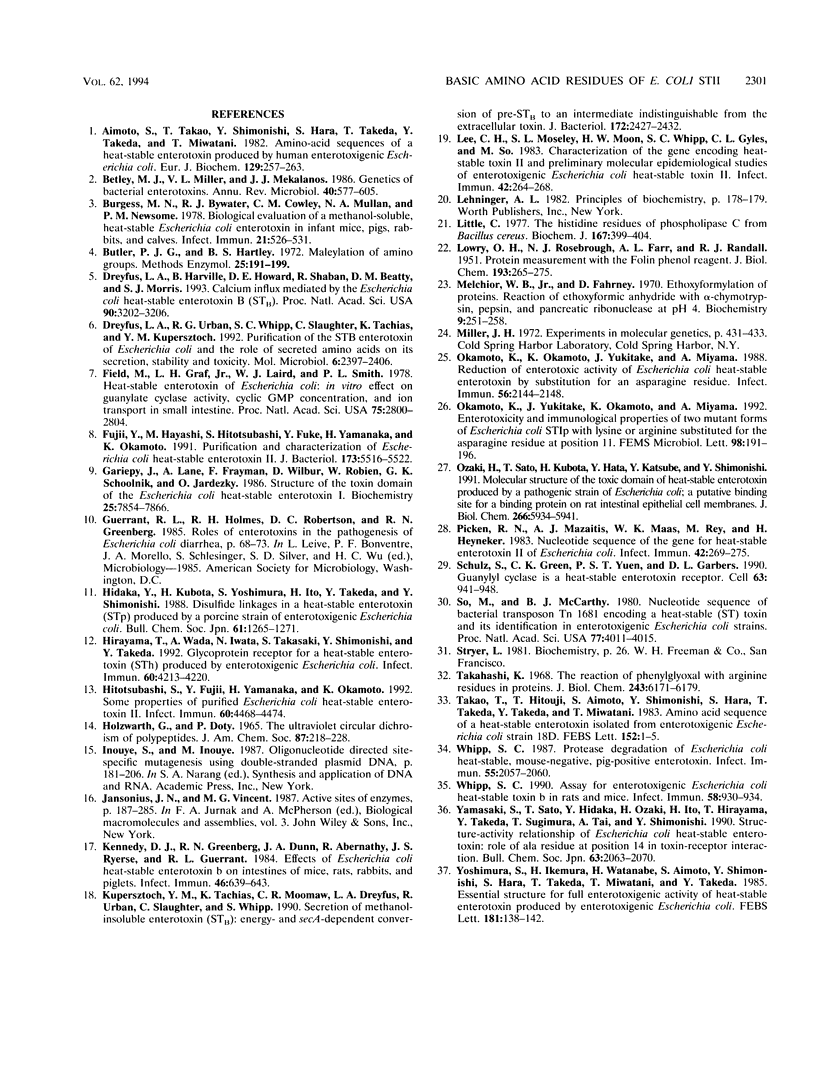
Selected References
These references are in PubMed. This may not be the complete list of references from this article.
- Aimoto S., Takao T., Shimonishi Y., Hara S., Takeda T., Takeda Y., Miwatani T. Amino-acid sequence of a heat-stable enterotoxin produced by human enterotoxigenic Escherichia coli. Eur J Biochem. 1982 Dec 15;129(2):257–263. doi: 10.1111/j.1432-1033.1982.tb07047.x. [DOI] [PubMed] [Google Scholar]
- Betley M. J., Miller V. L., Mekalanos J. J. Genetics of bacterial enterotoxins. Annu Rev Microbiol. 1986;40:577–605. doi: 10.1146/annurev.mi.40.100186.003045. [DOI] [PubMed] [Google Scholar]
- Burgess M. N., Bywater R. J., Cowley C. M., Mullan N. A., Newsome P. M. Biological evaluation of a methanol-soluble, heat-stable Escherichia coli enterotoxin in infant mice, pigs, rabbits, and calves. Infect Immun. 1978 Aug;21(2):526–531. doi: 10.1128/iai.21.2.526-531.1978. [DOI] [PMC free article] [PubMed] [Google Scholar]
- Dreyfus L. A., Harville B., Howard D. E., Shaban R., Beatty D. M., Morris S. J. Calcium influx mediated by the Escherichia coli heat-stable enterotoxin B (STB). Proc Natl Acad Sci U S A. 1993 Apr 15;90(8):3202–3206. doi: 10.1073/pnas.90.8.3202. [DOI] [PMC free article] [PubMed] [Google Scholar]
- Dreyfus L. A., Urban R. G., Whipp S. C., Slaughter C., Tachias K., Kupersztoch Y. M., Drefus L. A. Purification of the STB enterotoxin of Escherichia coli and the role of selected amino acids on its secretion, stability and toxicity. Mol Microbiol. 1992 Aug;6(16):2397–2406. doi: 10.1111/j.1365-2958.1992.tb01414.x. [DOI] [PubMed] [Google Scholar]
- Field M., Graf L. H., Jr, Laird W. J., Smith P. L. Heat-stable enterotoxin of Escherichia coli: in vitro effects on guanylate cyclase activity, cyclic GMP concentration, and ion transport in small intestine. Proc Natl Acad Sci U S A. 1978 Jun;75(6):2800–2804. doi: 10.1073/pnas.75.6.2800. [DOI] [PMC free article] [PubMed] [Google Scholar]
- Fujii Y., Hayashi M., Hitotsubashi S., Fuke Y., Yamanaka H., Okamoto K. Purification and characterization of Escherichia coli heat-stable enterotoxin II. J Bacteriol. 1991 Sep;173(17):5516–5522. doi: 10.1128/jb.173.17.5516-5522.1991. [DOI] [PMC free article] [PubMed] [Google Scholar]
- Gariépy J., Lane A., Frayman F., Wilbur D., Robien W., Schoolnik G. K., Jardetzky O. Structure of the toxic domain of the Escherichia coli heat-stable enterotoxin ST I. Biochemistry. 1986 Dec 2;25(24):7854–7866. doi: 10.1021/bi00372a011. [DOI] [PubMed] [Google Scholar]
- HOLZWARTH G., DOTY P. THE ULTRAVIOLET CIRCULAR DICHROISM OF POLYPEPTIDES. J Am Chem Soc. 1965 Jan 20;87:218–228. doi: 10.1021/ja01080a015. [DOI] [PubMed] [Google Scholar]
- Hirayama T., Wada A., Iwata N., Takasaki S., Shimonishi Y., Takeda Y. Glycoprotein receptors for a heat-stable enterotoxin (STh) produced by enterotoxigenic Escherichia coli. Infect Immun. 1992 Oct;60(10):4213–4220. doi: 10.1128/iai.60.10.4213-4220.1992. [DOI] [PMC free article] [PubMed] [Google Scholar]
- Hitotsubashi S., Fujii Y., Yamanaka H., Okamoto K. Some properties of purified Escherichia coli heat-stable enterotoxin II. Infect Immun. 1992 Nov;60(11):4468–4474. doi: 10.1128/iai.60.11.4468-4474.1992. [DOI] [PMC free article] [PubMed] [Google Scholar]
- Kennedy D. J., Greenberg R. N., Dunn J. A., Abernathy R., Ryerse J. S., Guerrant R. L. Effects of Escherichia coli heat-stable enterotoxin STb on intestines of mice, rats, rabbits, and piglets. Infect Immun. 1984 Dec;46(3):639–643. doi: 10.1128/iai.46.3.639-643.1984. [DOI] [PMC free article] [PubMed] [Google Scholar]
- Kupersztoch Y. M., Tachias K., Moomaw C. R., Dreyfus L. A., Urban R., Slaughter C., Whipp S. Secretion of methanol-insoluble heat-stable enterotoxin (STB): energy- and secA-dependent conversion of pre-STB to an intermediate indistinguishable from the extracellular toxin. J Bacteriol. 1990 May;172(5):2427–2432. doi: 10.1128/jb.172.5.2427-2432.1990. [DOI] [PMC free article] [PubMed] [Google Scholar]
- LOWRY O. H., ROSEBROUGH N. J., FARR A. L., RANDALL R. J. Protein measurement with the Folin phenol reagent. J Biol Chem. 1951 Nov;193(1):265–275. [PubMed] [Google Scholar]
- Lee C. H., Moseley S. L., Moon H. W., Whipp S. C., Gyles C. L., So M. Characterization of the gene encoding heat-stable toxin II and preliminary molecular epidemiological studies of enterotoxigenic Escherichia coli heat-stable toxin II producers. Infect Immun. 1983 Oct;42(1):264–268. doi: 10.1128/iai.42.1.264-268.1983. [DOI] [PMC free article] [PubMed] [Google Scholar]
- Little C. The histidine residues of phospholipase C from Bacillus cereus. Biochem J. 1977 Nov 1;167(2):399–404. doi: 10.1042/bj1670399. [DOI] [PMC free article] [PubMed] [Google Scholar]
- Melchior W. B., Jr, Fahrney D. Ethoxyformylation of proteins. Reaction of ethoxyformic anhydride with alpha-chymotrypsin, pepsin, and pancreatic ribonuclease at pH 4. Biochemistry. 1970 Jan 20;9(2):251–258. doi: 10.1021/bi00804a010. [DOI] [PubMed] [Google Scholar]
- Okamoto K., Okamoto K., Yukitake J., Miyama A. Reduction of enterotoxic activity of Escherichia coli heat-stable enterotoxin by substitution for an asparagine residue. Infect Immun. 1988 Aug;56(8):2144–2148. doi: 10.1128/iai.56.8.2144-2148.1988. [DOI] [PMC free article] [PubMed] [Google Scholar]
- Okamoto K., Yukitake J., Okamoto K., Miyama A. Enterotoxicity and immunological properties of two mutant forms of Escherichia coli STIp with lysine or arginine substituted for the asparagine residue at position 11. FEMS Microbiol Lett. 1992 Nov 1;77(1-3):191–196. doi: 10.1016/0378-1097(92)90154-g. [DOI] [PubMed] [Google Scholar]
- Ozaki H., Sato T., Kubota H., Hata Y., Katsube Y., Shimonishi Y. Molecular structure of the toxin domain of heat-stable enterotoxin produced by a pathogenic strain of Escherichia coli. A putative binding site for a binding protein on rat intestinal epithelial cell membranes. J Biol Chem. 1991 Mar 25;266(9):5934–5941. [PubMed] [Google Scholar]
- Picken R. N., Mazaitis A. J., Maas W. K., Rey M., Heyneker H. Nucleotide sequence of the gene for heat-stable enterotoxin II of Escherichia coli. Infect Immun. 1983 Oct;42(1):269–275. doi: 10.1128/iai.42.1.269-275.1983. [DOI] [PMC free article] [PubMed] [Google Scholar]
- Schulz S., Green C. K., Yuen P. S., Garbers D. L. Guanylyl cyclase is a heat-stable enterotoxin receptor. Cell. 1990 Nov 30;63(5):941–948. doi: 10.1016/0092-8674(90)90497-3. [DOI] [PubMed] [Google Scholar]
- So M., McCarthy B. J. Nucleotide sequence of the bacterial transposon Tn1681 encoding a heat-stable (ST) toxin and its identification in enterotoxigenic Escherichia coli strains. Proc Natl Acad Sci U S A. 1980 Jul;77(7):4011–4015. doi: 10.1073/pnas.77.7.4011. [DOI] [PMC free article] [PubMed] [Google Scholar]
- Takahashi K. The reaction of phenylglyoxal with arginine residues in proteins. J Biol Chem. 1968 Dec 10;243(23):6171–6179. [PubMed] [Google Scholar]
- Takao T., Hitouji T., Aimoto S., Shimonishi Y., Hara S., Takeda T., Takeda Y., Miwatani T. Amino acid sequence of a heat-stable enterotoxin isolated from enterotoxigenic Escherichia coli strain 18D. FEBS Lett. 1983 Feb 7;152(1):1–5. doi: 10.1016/0014-5793(83)80469-4. [DOI] [PubMed] [Google Scholar]
- Whipp S. C. Assay for enterotoxigenic Escherichia coli heat-stable toxin b in rats and mice. Infect Immun. 1990 Apr;58(4):930–934. doi: 10.1128/iai.58.4.930-934.1990. [DOI] [PMC free article] [PubMed] [Google Scholar]
- Whipp S. C. Protease degradation of Escherichia coli heat-stable, mouse-negative, pig-positive enterotoxin. Infect Immun. 1987 Sep;55(9):2057–2060. doi: 10.1128/iai.55.9.2057-2060.1987. [DOI] [PMC free article] [PubMed] [Google Scholar]
- Yoshimura S., Ikemura H., Watanabe H., Aimoto S., Shimonishi Y., Hara S., Takeda T., Miwatani T., Takeda Y. Essential structure for full enterotoxigenic activity of heat-stable enterotoxin produced by enterotoxigenic Escherichia coli. FEBS Lett. 1985 Feb 11;181(1):138–142. doi: 10.1016/0014-5793(85)81129-7. [DOI] [PubMed] [Google Scholar]


